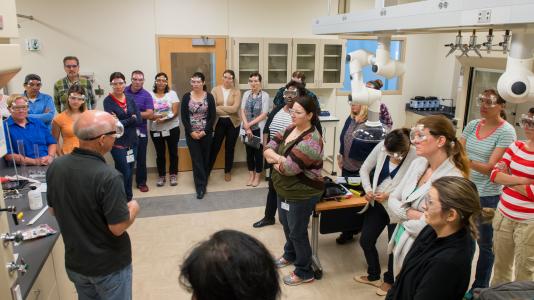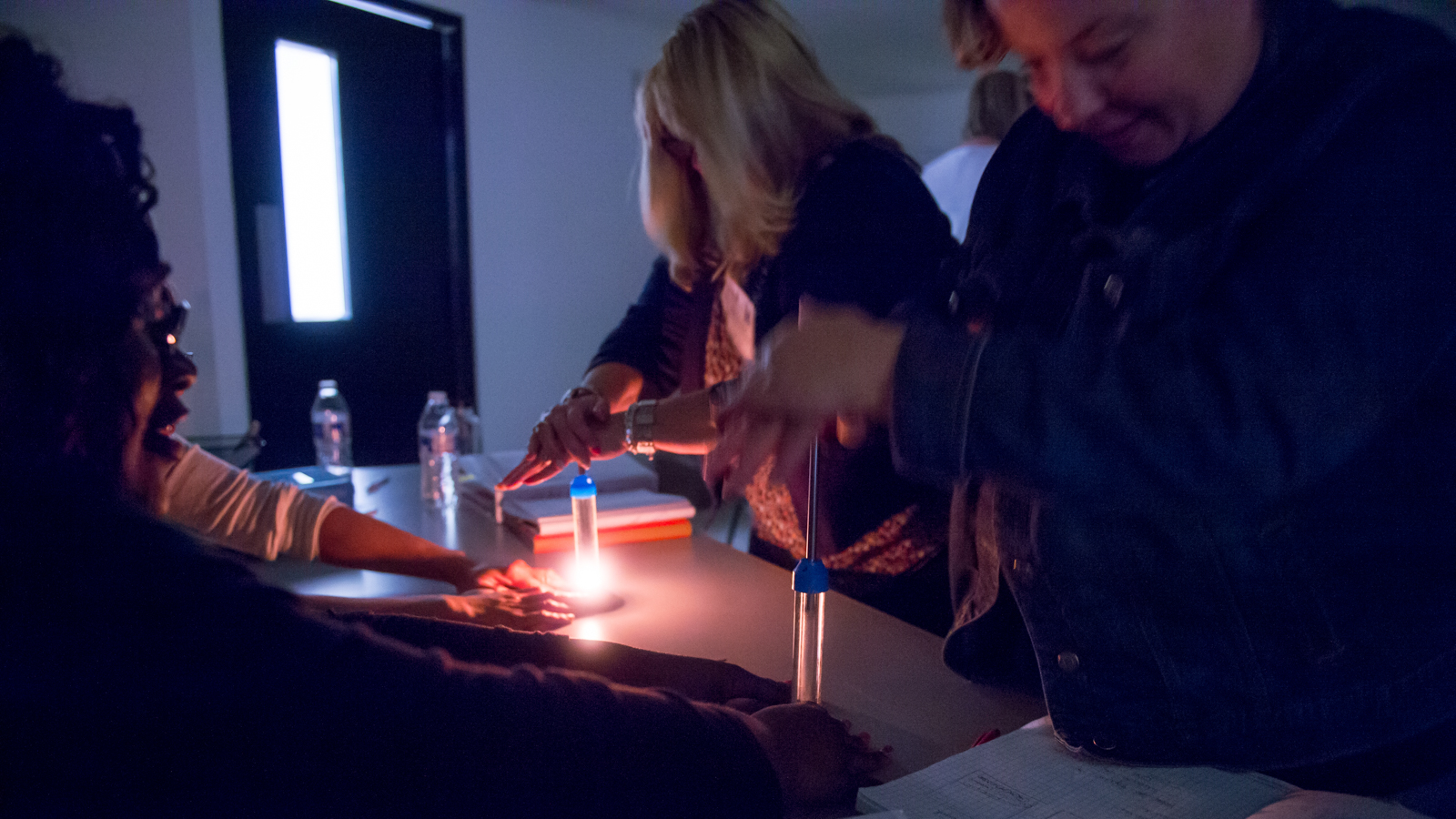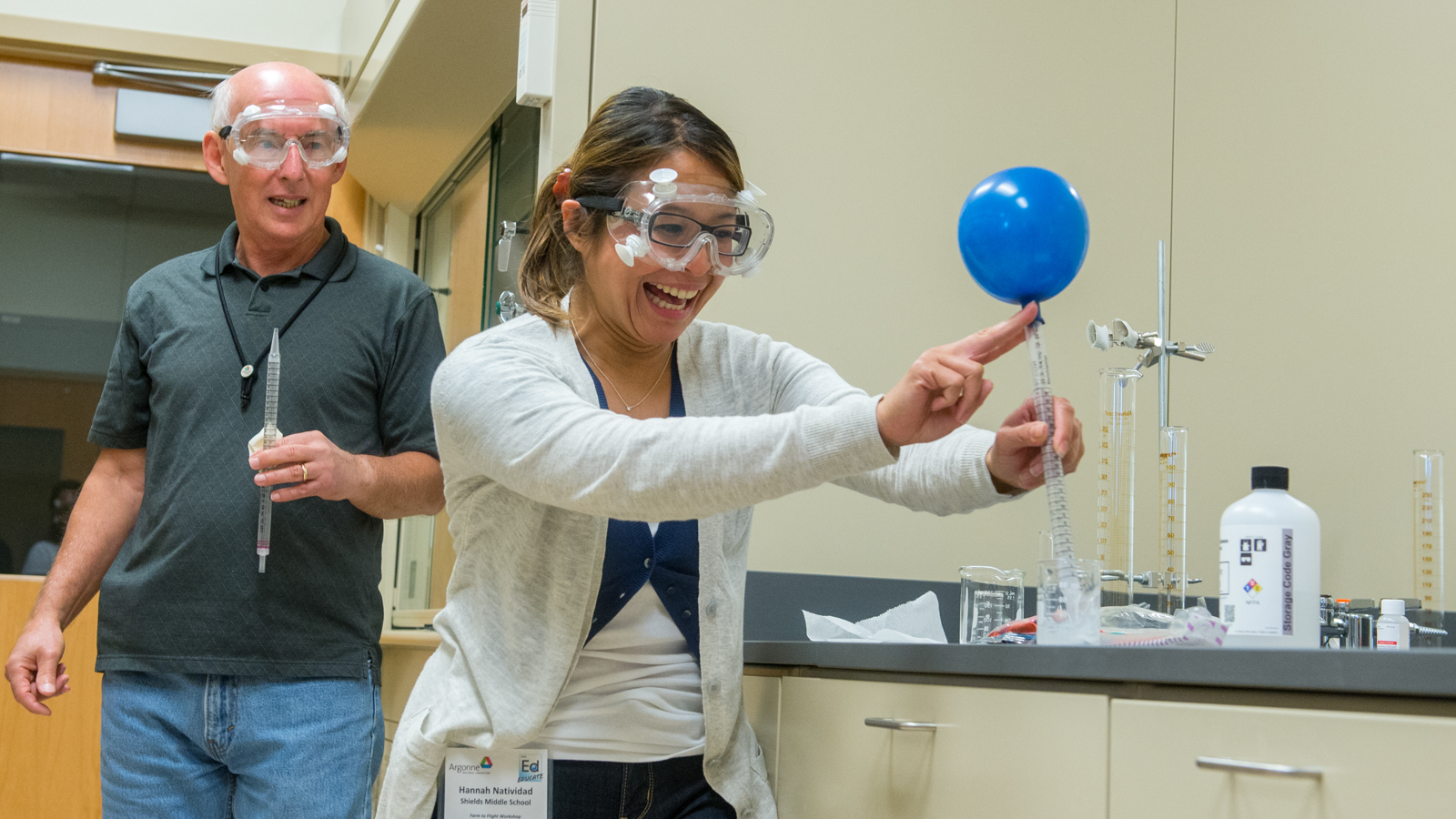
Lemont, Ill. – The U.S. Department of Energy’s Argonne National Laboratory and the iBIO Institute EDUCATE Center teamed up at Argonne last month for a teacher workshop called “Farm to Flight: Can Biofuels ‘Green’ Aviation?”
The three-day workshop merged Argonne’s research expertise with new science teaching standards to teach middle and high school science educators methods that will prepare their students for STEM-related careers. Specifically, educators learned to teach students how to argue from evidence, one of the many scientific practices presented in the Next Generation Science Standards (NGSS).
The Standards redirect K-12 science teaching methods from focusing on what science discovers to developing students’ ability to think critically about how scientific knowledge is created. Modern-day research depends on drawing together pieces of information from many disciplines to solve large and complex issues. Confronted with global challenges today and in the future, teaching any scientific discipline without reference to another, is like putting together a puzzle without all of the pieces.
“The four-week curriculum we designed models how to teach NGSS in the classroom,” said Meridith Bruozas, Manager of Educational Programs at Argonne. “It gives teachers a jump-start in the planning process by providing a comprehensive set of tools they can use in their classrooms now to start engaging in those rich and diverse discussions, hands-on labs, models and simulations that make learning science fun.”
The Argonne/iBIO EDUCATE collaboration presents a model for how current research could be integrated into the classroom, using airline fuel as an example—exploring the mechanics of combustion engines, greenhouse gas emissions and the differences between liquid and solid fuels to determine whether biofuel is a viable replacement.
In one instance, teachers created a simulation that modeled impacts of possible biofuel solutions given certain constraints. Using Argonne’s GREET (Greenhouse gases, Regulated Emissions, and Energy use in Transportation) fuel cycle modeling system, teachers were able to determine emission levels from initial production to combustion.
“We have been looking to partner with Argonne for some time,” said Ann Reed Vogel, Vice President of iBIO EDUCATE. “iBIO has deep expertise in the life sciences, but not the physical or energy sciences, so Argonne was a natural partner for us on this project.”
Integrating inquiry-based learning in the classroom—which considers real-world problems like “How would you replace traditional fuel with biofuels?”—fundamentally changes the teacher-student relationship. In this new model, the students generate the discussion by attempting to solve the problem, drawing on diverse resources and facilitating their own learning. It also gets away from the idea that each subject should be taught in a vacuum.
“In the old days, chemistry teachers taught chemistry, and physics teachers taught physics, and the ideas from one rarely made it into solutions of the other,” said Evergreen Park High School teacher Kathy Augustin. “Nothing is just chemistry or just physics. What makes NGSS cool is that you are forced to go to other curriculums to develop comprehensive solutions.”
Over three days, educators engaged in problem-solving discussions that separated what they know about biofuels from what they think they know. The goal: for the educators to experience the same level of instruction they will be sharing with their students, arming them with comprehensive experiences and tools with which to guide discussions in solving specific scientific inquiries.
“We’ve talked about strategies at other conferences, but never done them at the same time,” said Brad Walker, a science teacher at Cissna Park Senior High School. “This entire experience has given me a better understanding of how to actually implement an inquiry-based lesson plan in my classroom.”
“For us, this is a curriculum project, and the professional development is the vehicle to get the curriculum in the classroom,” said Bruozas. “We’re trying to help school districts and teachers by giving them resources to make this conceptual shift in teaching so that kids can continue to flourish.”
Argonne National Laboratory seeks solutions to pressing national problems in science and technology. The nation’s first national laboratory, Argonne conducts leading-edge basic and applied scientific research in virtually every scientific discipline. Argonne researchers work closely with researchers from hundreds of companies, universities, and federal, state and municipal agencies to help them solve their specific problems, advance America’s scientific leadership and prepare the nation for a better future. With employees from more than 60 nations, Argonne is managed by UChicago Argonne, LLC for the U.S. Department of Energy’s Office of Science. For more visit www.anl.gov. DOE’s Office of Science is the single largest supporter of basic research in the physical sciences in the United States, and is working to address some of the most pressing challenges of our time. For more information, please visit science.energy.gov.
DOE’s Office of Science is the single largest supporter of basic research in the physical sciences in the United States, and is working to address some of the most pressing challenges of our time. For more information, visit science.energy.gov.

